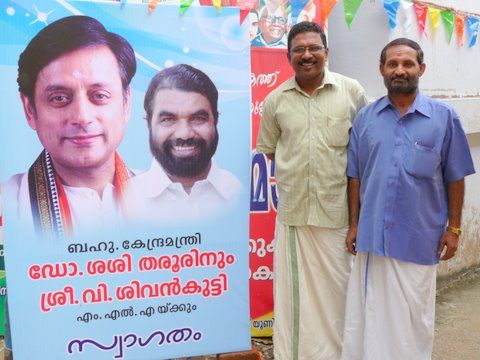Kochi (Cochin), November 23 – Party politics in this tropical state are as peppery as the cuisine, protest demonstrations are akin to street theater, and red banners blazoned with the hammer and sickle are as much roadway icons as shrines to Hindu gods and the ubiquitous images of Jesus. In 1957, arguably for the first time anywhere, Communists came to power here through a genuinely free election. Over five decades, Keralites have regularly switched from Communist-led coalitions to centrist blocs led by the Congress Party. In 2006, voters again awarded the Communists a five-year term.
So it was with some curiosity that we prepared to meet a sitting Communist official, Chairman K.P. Raveendran, who heads the municipal council in Thalassery. He greeted us in his office, where a dozen aides crowded around us. Coconuts with straws were politely offered, as well as a sheet in handwritten English celebrating the district's history.
The forty-something chairman dressed informally—no one wears ties in Kerala—and tended to the opaque commonplaces one hears from local party bosses everywhere. His career? He rose through the youth wing of the Communist Party then became a full time organizer and a member of the municipal council. But, we wondered, since there are far more shopkeepers than factory workers in Kerala, and since three religions permeate the state, where does party get its votes? "We welcome the votes of whoever supports our goals." How then does his party differ from European Social Democrats? "Our party has an international Marxist ideology," he frowned, adding that it was less dependent on a single leader (at least in Kerala). And evidently it is also an ecumenical party. The Chairman announced: "I'm a Hindu; my number two is a Muslim."
We then ventured an offbeat question. We had been told that Keralite Communists consulted astrologers to determine auspicious dates for major events. Was this true? A nervous buzz could heard around the room. The chairman consulted a colleague. Well, yes, out of respect for local traditions, he said, "All practices continue." Scientific Marxism obviously marches to a different drummer in this tropical state.
That impression was enhanced by a memorable day we then spent in a village on the outskirts of Thrissur. There we dined with the families of two octogenarian Brahmins. Both had been pillars of the Left, to the extent of joining the fight for land reform, at the cost of shrinking their own rice-rich acreage (with token compensation). How this came about was detailed by Subramanian Nampoothiri, a dramatist and reformer within the Namboodiri community. Wearing the traditional dhoti and the Brahmin's sacred thread, he recalled distant days when it was sacrilege for his priestly caste even to set eyes on lower-caste villagers. Namboodiris would shout "Ho" to warn untouchables to hide themselves when they approached. It was also forbidden for Dalits to enter Hindu temples, and an abomination for their women to cover their breasts. Like others in his caste, he rebelled against this oppressive code, and during India's freedom struggle joined the Communists, whose members were then allies of the mainstream Congress Party.
When the Keralan Communists won office in 1957, many of its senior ministers were Brahmins and Nairs, Kerala's martial caste. Over the decades, they indeed dissolved anachronistic caste barriers, promoted land reform, launched literacy campaigns and brought health services to villages, laying the basis for the vaunted Kerala Model. As a result, in Nampoothiri's words, "There's not much difference today between the village and town," thereby sparing Kerala from the tidal migrations from the countryside to slums in overstretched cities. And Kerala's citizens achieved near-universal literacy, the accomplishment that most surprised and pleased our Brahmin comrade.
Tellingly, one result is that the Hindu fundamentalist party, Bharatiya Janata Party, or BJP, has failed to win a single Kerala seat in the national parliament or in the state assembly; it averages only about 6 to 8 percent of the state's vote.
Kerala's party leaders have thus widened a trail blazed by other dissenters within the Communist mother church, figures like Bukharin in Russia, Gramsci in Italy, Dubcek in Czechoslovakia and finally, Mikhail Gorbachev. But looking back, it seems fair to remark that while the party presided over major tactical victories, its strategic vision proved problematic. Kerala remains a state with deep pockets of poverty and it copes with India's highest rate of unemployment. Its economy, moreover, remains hostage to external market forces it cannot hope to influence. It has evolved into a consumerist society that arguably cannot be sustained without compromising its social ecology – points we plan to elaborate in our next report.
When the Brahmin Vasudevan Nampoothiri, a former newspaperman, Sanskrit scholar and educator, was asked if after his long years in the service of his cause if he was disappointed in Communism? Did he have any regrets? "Yes, that we didn't manage to alleviate poverty. If anything the gap between the rich and the poor has gotten even wider."











